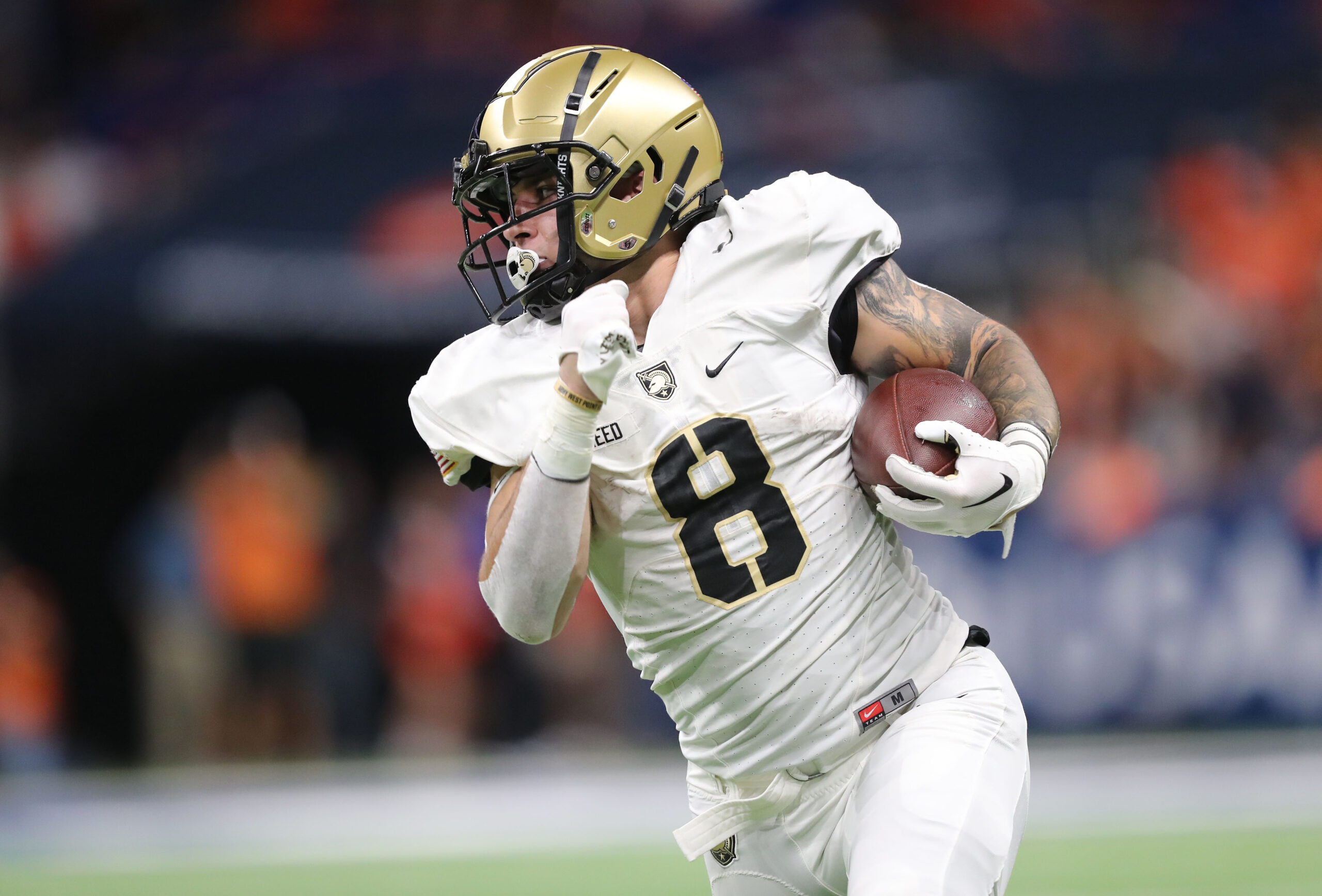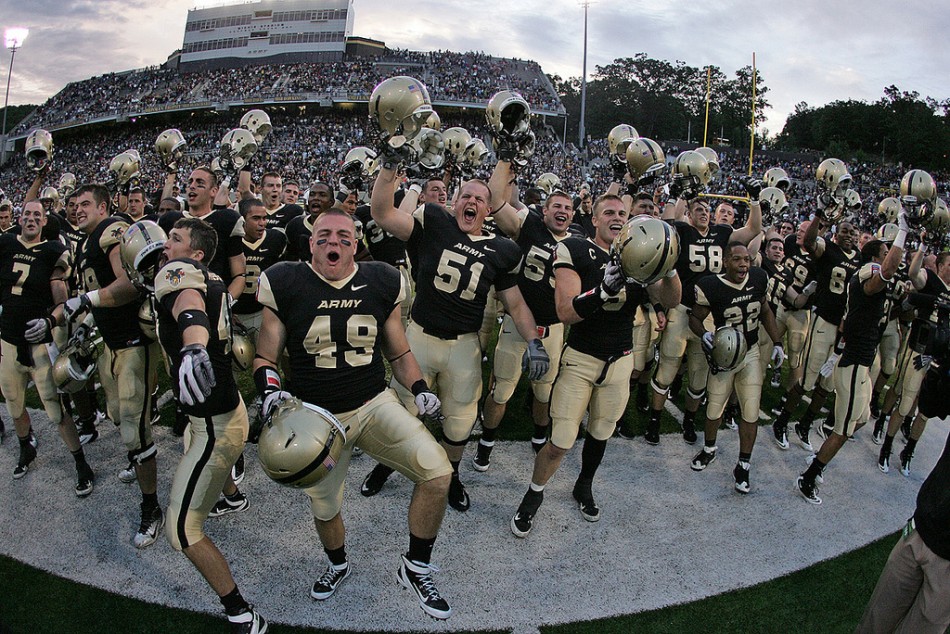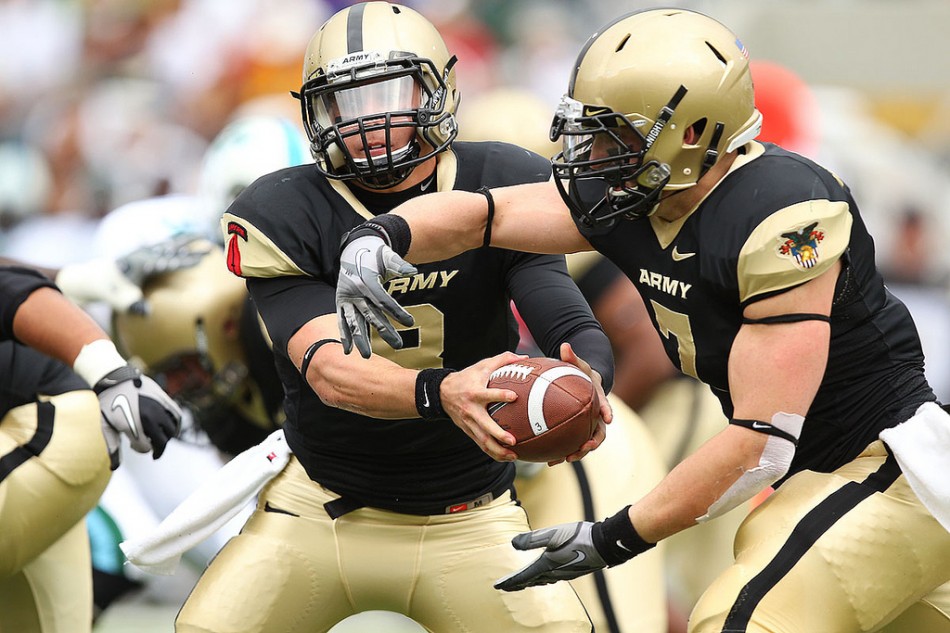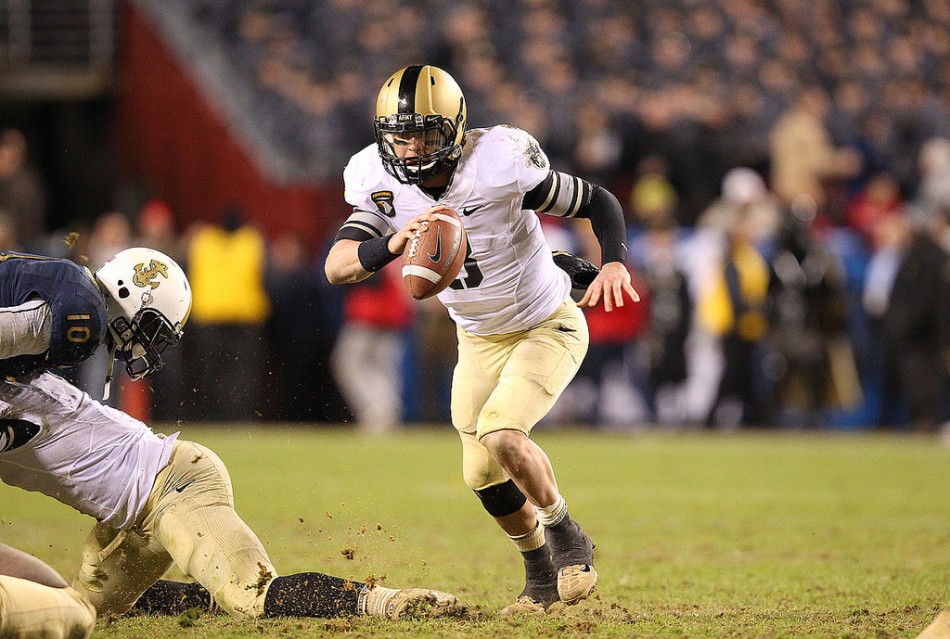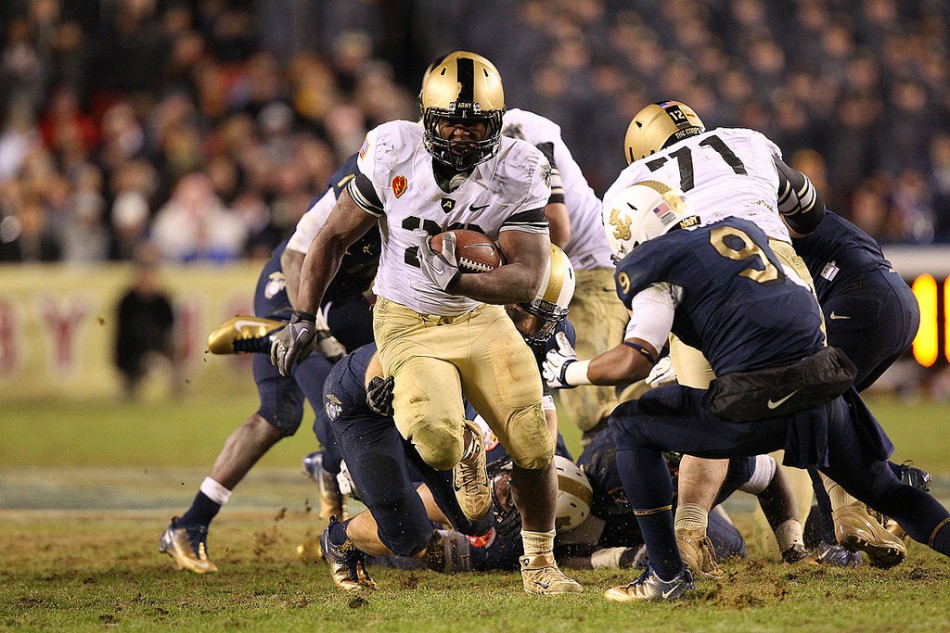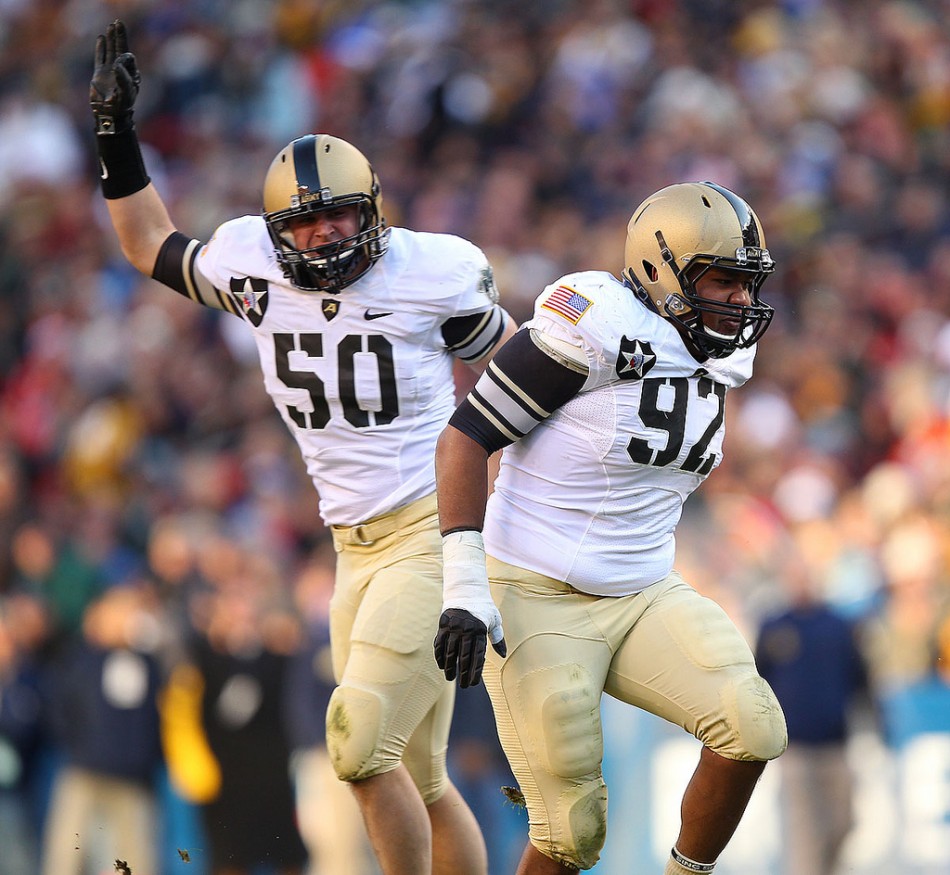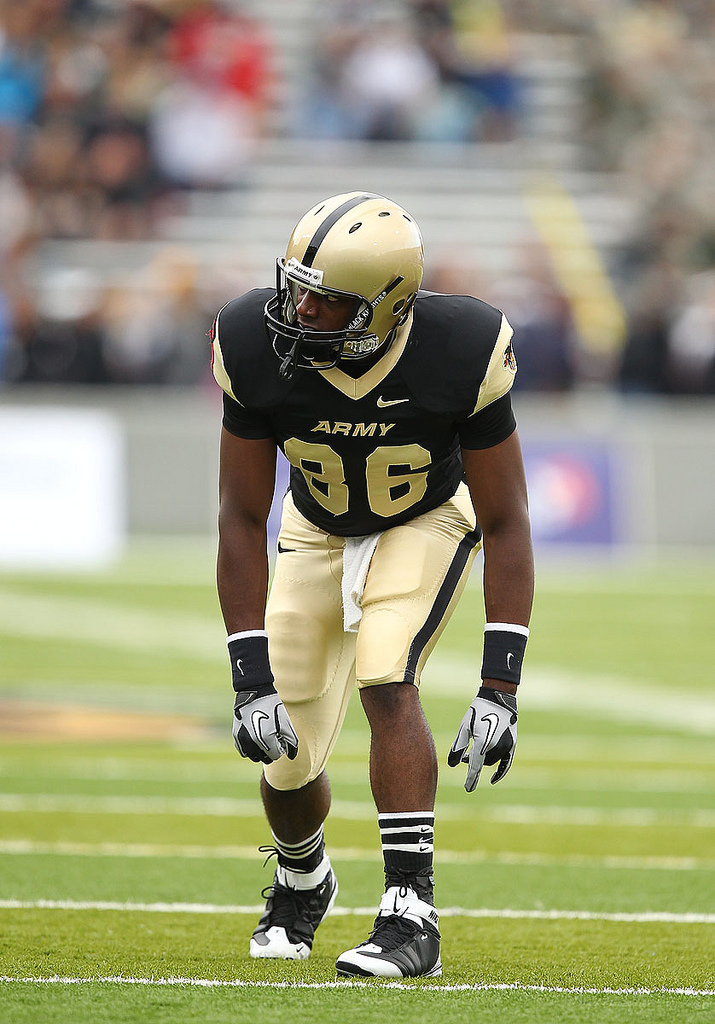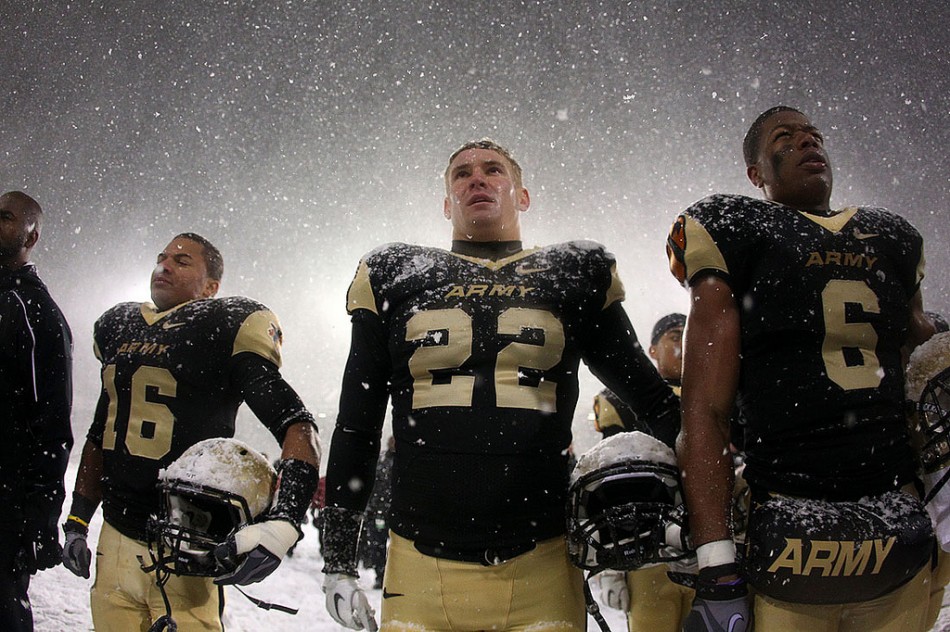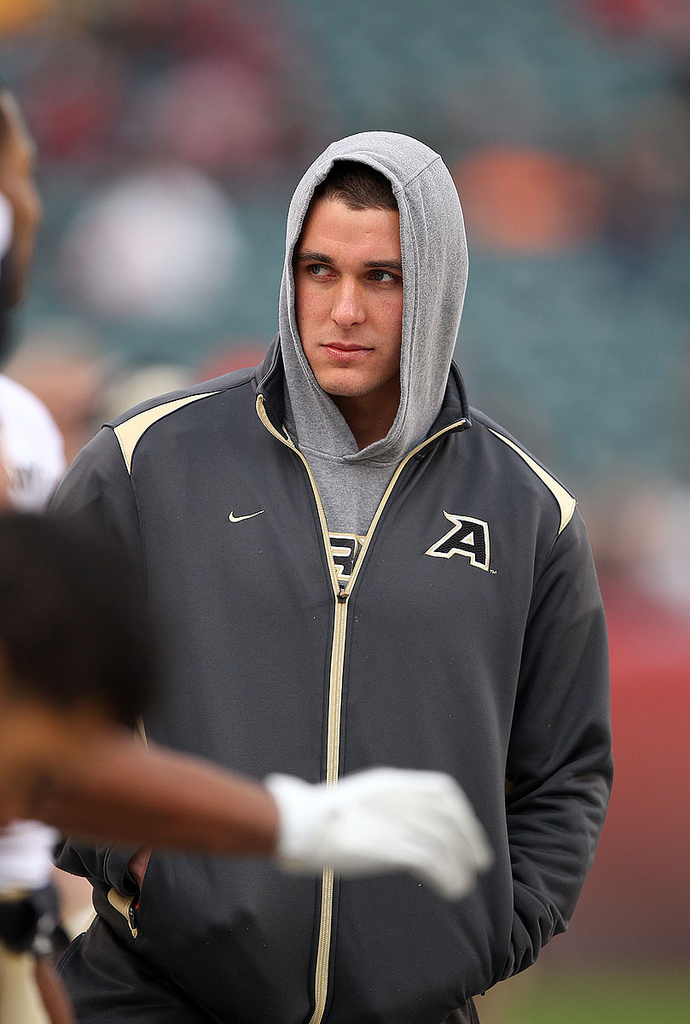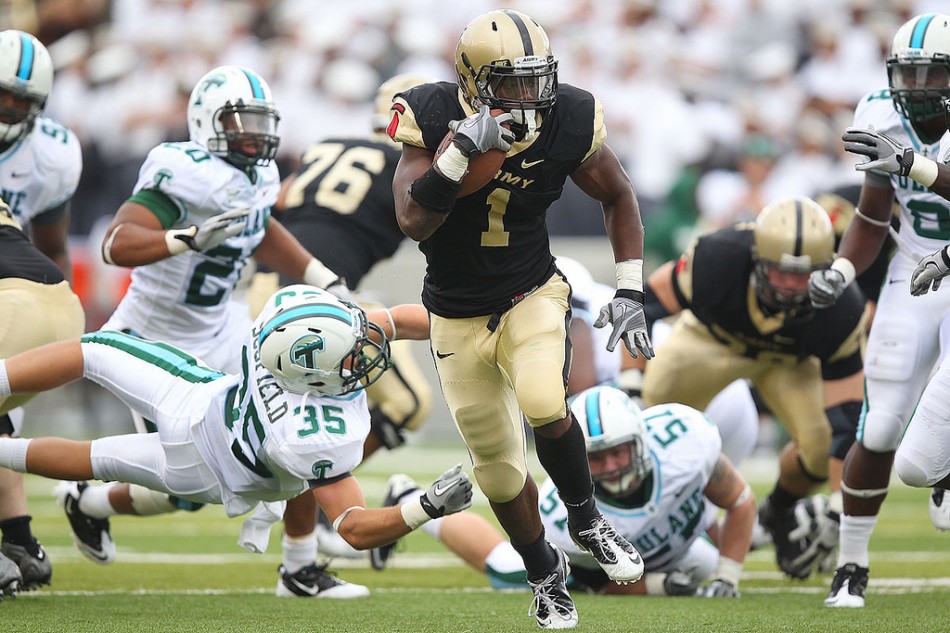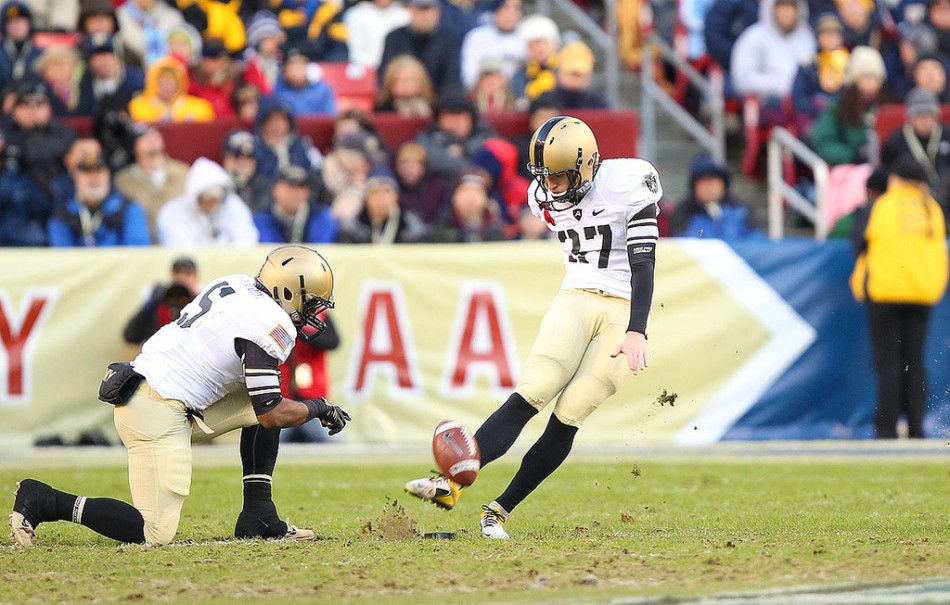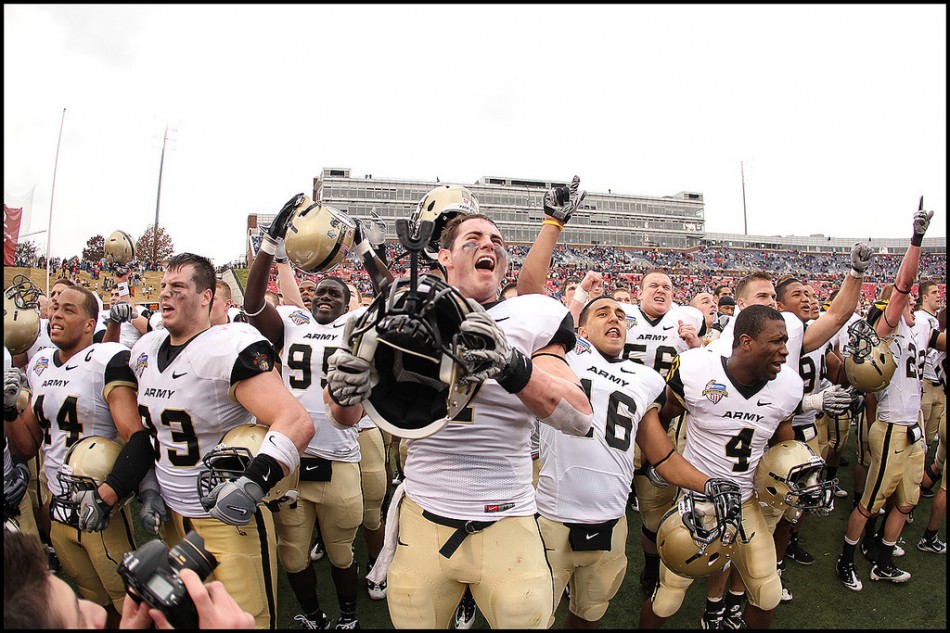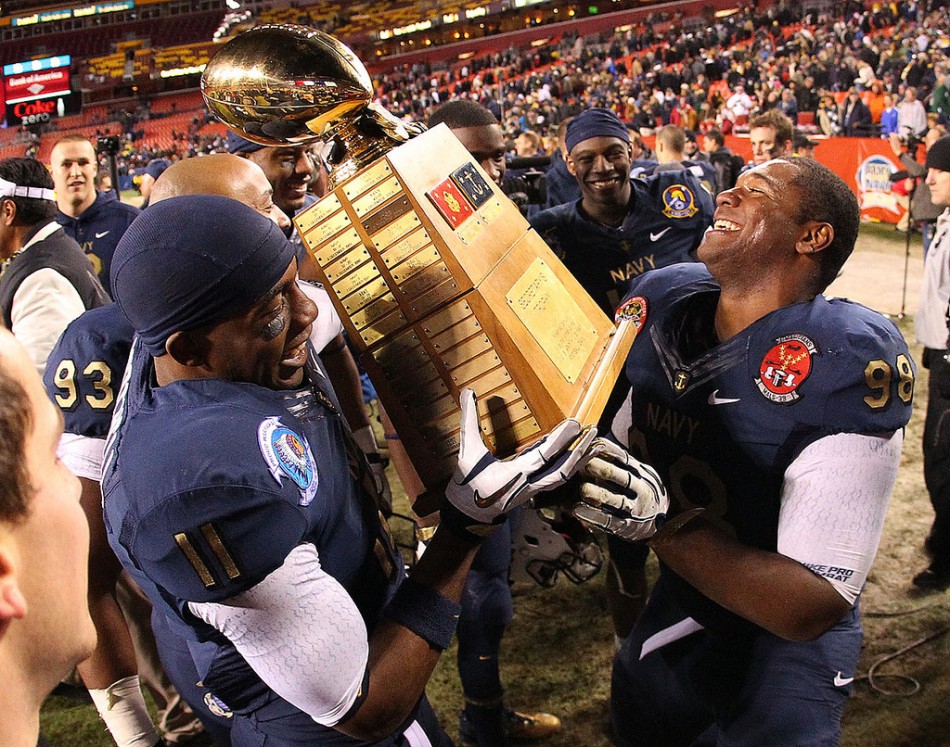We’re less than a month away from the season opener, and with Army putting on the pads in its fifth practice on Aug. 11, things are getting serious. Army begins its season on Sept. 8 at San Diego State, a team they lost to last season by just three points at home. The Black Knights return to Michie Stadium a week later to host Northern Illinois. They’ll need at least six wins before playing Navy to qualify for their slot in the Military Bowl against an ACC opponent. Let’s take a look at some of the larger questions facing the team heading into September:
1. Can Army hold on to the ball and cut down on fumbles?
Turnovers were the No. 1 headache for Army’s offense last season, a year after they prided themselves on being among the top teams in the nation in turnover ratio. Perhaps a consequence of running the ball to the extreme, the fumbling issue last year was widespread and often snuck up at crucial moments. Here’s a scary number: 22. Here’s a scarier number: 36. Army had 36 fumbles in 2011 and lost 22 of them. To put that into perspective, no other Division 1 FBS team even had 20 lost fumbles. That’s three fumbles a game on average.
Army had a -.75 turnover ratio, which ranked No. 108 out of 120 (believe it or not, Notre Dame, Florida and SMU were all worse). Army also got picked four times, so that 26 turnovers in 12 games. I saw it all happen myself and it’s still hard to believe.
So, can they improve? Obviously. I don’t know what the issue was last season, whether teams are specifically going for strips or what. It was frustrating to watch. The good news is that, despite the turnovers, Army ranked No. 1 in the nation in rushing yards per-game (346.5), second in total rushing yards with 4,158 (Oregon had 4,189), fifth in yards per-carry (5.6) and tied with LSU for 10th with 35 rushing touchdowns. Not surprisingly, Army led the nation as well in rushing attempts (Air Force, Georgia Tech and Navy all trailed, in that order).
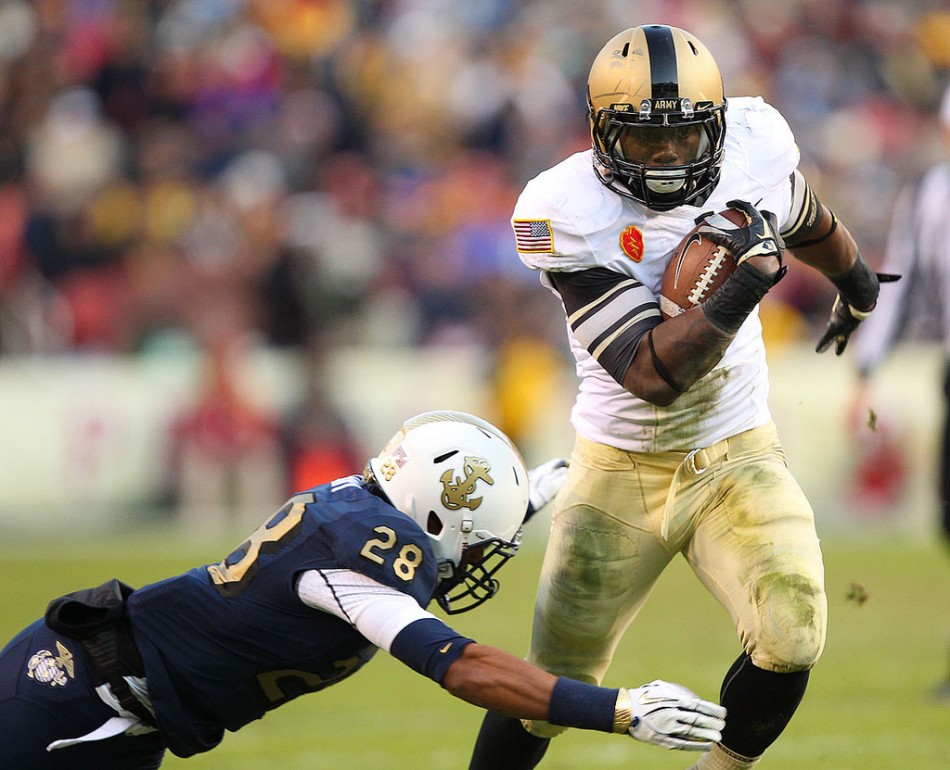
This is fundamental, discipline-type stuff that all the service academies should excel at.
2. Who are the key players for 2012?
Army lost only two really big names from last season: co-captains Steve Erzinger and Andrew Rodriguez, both linebackers. Offensively, the team looks pretty similar outside some new faces at wide receiver, although — and this may be hard to believe — Army ranked dead last in 2011 in passing attempts, so the receiving corps sort of takes a back seat in that regard. Senior quarterback Trent Steelman runs the option offense like a machine when healthy and could have his best season yet this year with his experience, knowledge and array of running options at his side. Despite missing about four games with ankle and knee injuries, he still finished second in the FBS among quarterbacks with 12 rushing touchdowns. He was Army’s second-leading rusher, led the team in rushing touchdowns and is the only Army player in academy history to rush for 2,000 yards and pass for 2,000 yards during his career.
Steelman enters 2012 ranked No. 5 on Army’s all-time total offense list with 4,128 yards — pretty incredible considering the program’s history. He needs 2,371 yards to break the Academy record, which ain’t happening this year, but he’ll obviously finish among the program’s greats. What’s within reach, though? Steelman needs just 242 rushing yards and eight rushing touchdowns to break both USMA records.

“Trent comes out of the spring very healthy,” Ellerson said. “It’s probably the healthiest he’s ever been, frankly. It’s obviously a difficult job. He’s going to have the ball in his hands, and his legs are very important to our offense. What we need to do is make sure we can develop and get him to grow without putting him in a physical deficit in the practice environment. Things are going to happen in games. We just don’t need to do anything silly on the side to set ourselves back.”
There are rumblings Ellerson may open up the passing attack this season, borrowing a shotgun or pistol formation from Navy and, early on, Steelman has looked good throwing the ball inside Foley, working in a no-huddle offense and hitting targets for short-yardage plays.
Again, this offensive unit eats up yardage on the ground, with Raymond Maples leading a really solid group of running backs that includes fullback Larry Dixon, running back Jared Hassin and a few other speedy options like Brian Austin, Terry Baggett, Stephen Fraser, Jon Crucitti, Trenton Turrentine and Kelechi Odocha. Ellerson is also impressed with another fullback in Hayden Tippett. Malcolm Brown, who ranked third in rushing yards last season, is being converted to a wide receiver this summer, so unless that change doesn’t stick, we can count him out of the backfield.
Maples posted the 15th 1,000-yard rushing campaign in USMA history last year after Hassin accomplished the feat as a sophomore transfer in 2010 at fullback. Maples also set a USMA record with 7.3 yards-per-carry last year among rushers with at least 100 attempts. He’s fast, strong and has lot of experience now working in this offense under head coach Rich Ellerson.
“I look at the board and I see two or three guys at both of those slot positions who are really good football players, and in some cases they’re veteran football players like Raymond Maples and Malcolm Brown,” Ellerson said. “Then there are some young guys with all kinds of upside who started as freshmen at different times during the season like Trenton Turrentine, Terry Baggett and Stephen Fraser. Then you go out for spring football and you can’t have a full practice because you don’t have enough running backs that are healthy.”
“It was a thick group that had a heck of a time practicing because of a sprain or a strain,” Ellerson said. “There are some guys that just have hard time being healthy. I don’t think that’s the nature of this particular group, but that’s what I’m concerned about. It doesn’t matter how many good players you have if they’re always hurt. If they were all healthy every day, we would have a challenge getting the requisite amount of reps for everyone.”
Dixon emerged last year as a freshman to split carries at fullback with Hassin, eventually bumping Hassin into a running back role by the end of the year. Both are incredibly strong ball-carriers and get dirty on short-yardage situations, but they’re both capable of busting out a long run. Hassin had some back issues in the past, so perhaps this combination this season will help keep everyone fresh and healthy.
“I feel really great about the fullback position,” Ellerson said. “We have Larry Dixon and Hayden Tippett, and I’m really excited about those two guys. They’re really a 1-2 punch. You’ve also got Jared Hassin, who has a thousand turns at that position. The fullback, just like the center and the quarterback, those positions that are right down the middle of your offense, are so crucial to our success. We can’t feel better about them.”
Frank Allen and Ryan Powis are the two notable names coming back to the offensive line along with Will Wilson, who started last season at center but is being transitioned to right tackle.
Defensively, Army gets legacy captain Jarrett Mackey back after he hurt his leg in the 2011 season opener and thus gained another year of eligibility. He’s a junior but will graduate in Dec. 2013. Lineman Zack Watts, now a senior, is back and a good playmaker. Holt Zalneraitis will be counted on this season after moving from tackle to “whip.” Otherwise, it’s a pretty inexperienced group here, and no one is especially big.
“Whip” Nate Combs, “bandit” Jacob Drozd and linebacker Georffrey Bacon also return, but injuries have limited Combs since the spring.
“Sometimes you’re asked to be a defensive lineman; fine, [Drozd has] been one,” Ellerson said. “Sometimes you’re asked to be a linebacker and a pass rusher; he’s done all those things and been first-team doing all those things. Some of those guys [at bandit] are much stronger at part of that job description than others. He [Drozd] has a chance to be extraordinary at all of them.”
The defensive backs are pretty familiar — Josh Jackson, Justin Trimble, Thomas Holloway, Hayden Pierce, Tyler Dickson and Ty Schrader all return.
“You’ll see Kyler martin and Ty Shrader battling at free safety, and Tyler, Waverly Washington and Justin Allen battling it out at the boundary corner position,” Ellerson said. “That was one of our goals this spring was to make sure those positions were competitive. We’ll add in a really gifted newcomer at each of those positions come fall camp. Those guys have played a lot of football for us. We’re going to leverage those things they’ve done well for us in the past, we’re going to expand the job descriptions just a little bit, and give them each a chance to be in the front of the line.”
3. Will Army expand its offense with a passing game?
Ugh, I hope so. As mentioned, Brown has been moved from slotback to wide receiver as Army scrambles to replace Davyd Brooks (a senior last year best remembered for his game-sealing last-second clutch catch in the Armed Forces Bowl) and local product Jared McFarlin, who ranked second in receiving yards last season but left the team during spring practice. Another slotback, Scott Williams, has been moved to WR this summer to compete for a role.
Army’s receivers don’t have a ton of experience here, with a four-player rotation — Anthony Stephens, Chevaughn Lawrence, Patrick Laird and E.J. Tucker — that combined last year to catch four passes for 77 yards and a touchdown. Army was the only team in the nation in 2011 to attempt fewer than 100 passes all season — even Navy had 135. Brown, Laird and Tucker have all begun summer practices as the first team offensive receiving unit.
Laird and Lawrence are both 6-foot-3, the tallest of the receiving options.
This is all assuming Steelman stays healthy — last year, Max Jenkins and Angel Santiago both saw time and limited success throwing the ball. Steelman completed 53 percent of his passes and averaged 7.3 yards per pass attempt, but Jenkins and Santiago combined completed just 13 of 52 passes.
“It’s going well,” Brown said of his transition. “I’m just trying to get the dimensions of the offense at receiver down. It’s similar to being a running back, but there are obviously some differences.
“I’ve been here for four years so I’ve seen receivers go through the program, and that’s helped me out. My sophomore year I was there for pre-season practice so I got some work in, and now I’m just building off that.”
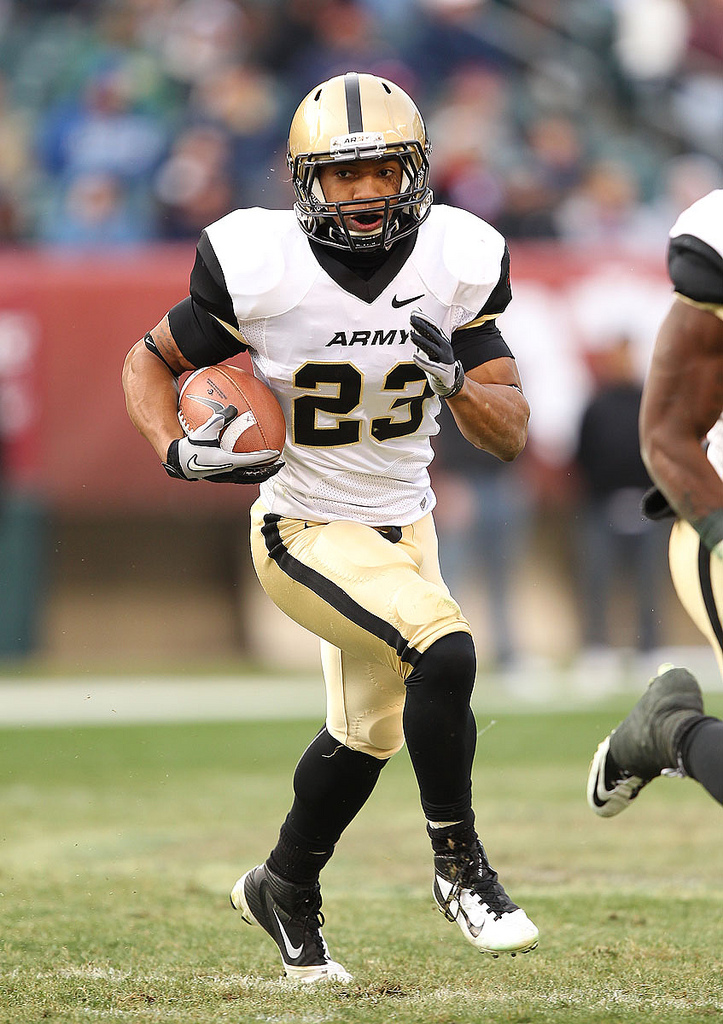
4. How will the defense hold up without Steve Erzinger and Andrew Rodriguez?
Erzinger led the team with 103 tackles last season and was the face of the defense. A-Rod ranked fourth with 59 tackles. So, who steps up? Holloway and Bacon both finished No. 2 and 3 in tackles last year, and Combs and Watts both led the team with three sacks apiece. A.J. Mackey is probably the biggest guy on the D-line this year and should form a nice duo with his brother.
“Bacon, Thomas Holloway and Justin Trimble have all played a lot of football for us,” said Co-Defensive Coordinator Payam Saadat. “They have to take the place of a guy like Steve Erzinger, and that’s tough, but those three can do it. At the bandit linebacker position we have Nate (Combs) back, and he seems to be full go and healthy. There is a group of young guys and some older veterans behind him as well. The linebacking corps is going to be okay.”
“This defense has a chance,” Ellerson said. “We said coming out of spring that when you look back at this team, and we’re the defense we think we are, we will look at the defensive front and say that was a real difference. I don’t care where you are, it’s awfully difficult to play in the second row. It’s awfully difficult to play corner. There’s even more pressure if the defensive line is struggling. We just had some issues on the defensive front that have, frankly, been resolved. We have better people in the mix in there, and some of the guys like Zalneraitis, who should be playing end, are back playing end. He’s a really good end and had a great spring playing where he should be. When we look back at this team I suspect we’ll say that this defensive front was so improved and gave this team a chance to be a consistently good, occasionally great defensive football team.”
5. Can Steelman stay healthy for the entire season?
For a while, he seemed indestructible.
Then an ankle injury cost him three games, and a knee issue kept him out of all but two snaps in a forgettable loss at Temple. He bounced back against Navy, but as an option QB, he takes a pounding. I think if Army can at least just add the threat of a passing attack, it should reduce some of the pressure on Trent. He’s a good decision-maker and obviously a great playmakrer.
Army quarterbacks were sacked 11 times last year, which ranks No. 11-best in the nation (Boise State led the FBS with eight allowed). But again, Steelman often takes the ball himself up the middle and into a wall. I’d like to see some more outside runs considering the speed of Maples and the slotbacks — anything to keep Steelman fresh.
An injury in the spring has actually helped him coming into summer camp.
“This is his team right now, and I’m trying to learn everything I can from him,” freshman QB AJ Shurr said during the second practice. “I try to watch everything he does, how he leads, how he goes about practice and how he does every drill.”
6. Can Raymond Maples replicate his 1,000-yard rushing effort?
Definitely, if healthy. Maples is still just a junior and has shown huge potential and play-making ability since becoming a featured back in 2011. He was also named to pre-season watch list for the Doak Walker Award, given annually to the nation’s top running back.
“We’re going to try and score on every play,” Maples said. “Last year we showed we had the potential, but this year I think we’re really going to execute. I feel as though I still should have a pretty good season. We have a lot of other offensive players that can carry the load. We have Trent, Larry, Jared, Malcolm Brown — a lot of players that can shine when they have to. I think everyone should be pretty good.”
7. Can Eric Osteen step up in the kicking game?
A valid question after Alex Carlton set academy records early in his career but was shaky at best in 2011 while Osteen was limited to kickoffs. Army attempted 34 fourth-down conversions in 2011, the second-most in the nation, and attempted just six field goals (Carlton made only three of them). So, a reliable option here will be huge. To borrow Army’s recap of the team’s third practice: “Senior Eric Osteen was the most successful of the group, drilling all three of his 37-yard field goal tries with plenty of leg. Army shuffled through four kickers. Joining Osteen was junior Billy Fisher and freshmen Cale Brewerand Dan Grochowski.”
8. How does this year’s schedule compare to the last few seasons?
Army went 3-9 last season after what they believed to be decisive winning season in 2010 — injuries, turnover and inexperience hurt this group last year, and playing teams like Northwestern, Rutgers, Vanderbilt and Temple proved to be tough matchups. Also keep in mind, one of those three wins came against an inept Fordham team in a Halloween blizzard that would have impressed Santa Claus.
This year, the schedule has some very winnable games: Wake Forest, Boston College, Kent State, Eastern Michigan and Ball State all finished at or below .500 last year (EMU and Ball State both went 6-6, while Stony Brook is an FCS/I-AA team that went 9-4 against smaller schools in the Big South). Considering Army hung with San Diego State last season, it’s feasible they can pick up some wins here. Northern Illinois (11-3 in the MAC West last year) in Week 2 should be tough home opener, and Army also dropped a game to Ball State last year, allowing 48 points, but the cadets can make up ground in that stretch before finishing against a string of tough matchups with Air Force at West Point, Rutgers on the road, Temple at home and Navy in Philly.
“Well, we have expectations,” Ellerson said, “and they’re high.”
9. Can Army get back to a bowl game?
Again, if they take care of business against beatable teams like Wake, BC, Kent, EMU and Ball State, that’s five wins. They’d need to eek out one more against Stony Brook or SD/Northern Illinois. And that’s it, they’d qualify for the Military Bowl, which is scheduled for Dec. 27 at RFK Stadium in Washington. They’d play an ACC team and follow Air Force and Navy in competing in this showcase.
10. Can they finally beat Navy?
You’re asking me? I have no idea. The string of heartbreak and frustration has lasted a decade. Army has seen some of its best players in recent memory come and go, spending four years without a win against the Mids. Last season, the optimism was there since Ricky Dobbs was out of town. And after QB Kriss Proctor resigned from the team following a reported honor code violation, he’s another headache off Army’s list. So is Alex Teich, the bruising fullback who graduated in the spring. And heck, Navy is coming off a 5-7 season too. Maybe this is the year?
